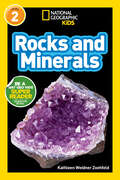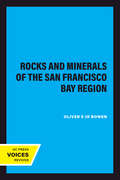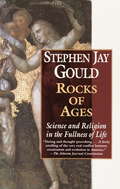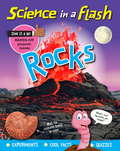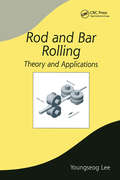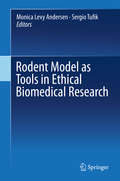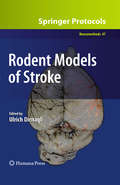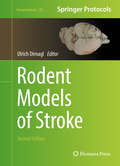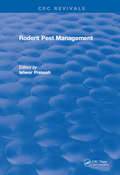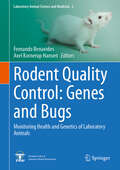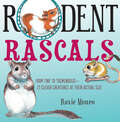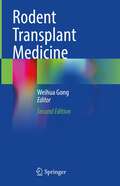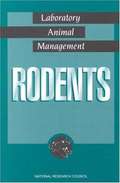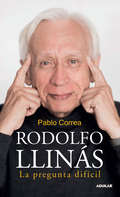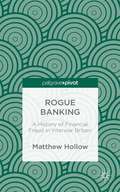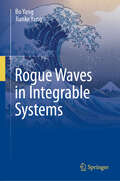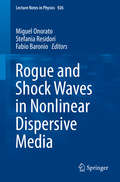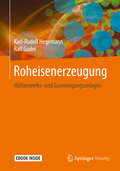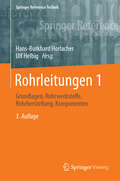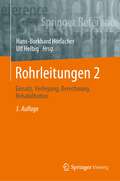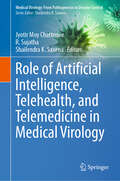- Table View
- List View
Rocks and Minerals (National Geographic Kids Readers)
by Kathleen ZoehfeldFrom dazzling gemstones to sparkling crystals to molten lava, this brilliantly illustrated book introduces children to the exciting world of rocks and minerals, including both the building blocks and the bling. This level two reader, written in easy-to-grasp text, will help cultivate the geologists of tomorrow!This high-interest, educationally vetted series of beginning readers features the magnificent images of National Geographic, accompanied by texts written by experienced, skilled children's book authors. The inside back cover of the paperback edition is an interactive feature based upon the book. Level 1 books reinforce the content of the book with a kinesthetic learning activity. In Level 2 books readers complete a Cloze letter, or fun fill-in, with vocabulary words.Releases simultaneously in Reinforced Library Binding: 978-1-4263-1039-3National Geographic supports K-12 educators with ELA Common Core Resources.
Rocks and Minerals of the San Francisco Bay Region (California Natural History Guides #5)
by Oliver E BowenThis title is part of UC Press's Voices Revived program, which commemorates University of California Press’s mission to seek out and cultivate the brightest minds and give them voice, reach, and impact. Drawing on a backlist dating to 1893, Voices Revived makes high-quality, peer-reviewed scholarship accessible once again using print-on-demand technology. This title was originally published in 1962.This title is part of UC Press's Voices Revived program, which commemorates University of California Press’s mission to seek out and cultivate the brightest minds and give them voice, reach, and impact. Drawing on a backlist dating to 1893, Voices Revived</DIV
Rocks of Ages: Science and Religion in the Fullness of Life
by Stephen Jay Gould"People of good will wish to see science and religion at peace. . . . I do not see how science and religion could be unified, or even synthesized, under any common scheme of explanation or analysis; but I also do not understand why the two enterprises should experience any conflict." So states internationally renowned evolutionist and bestselling author Stephen Jay Gould in the simple yet profound thesis of his brilliant new book.<P><P> Writing with bracing intelligence and elegant clarity, Gould sheds new light on a dilemma that has plagued thinking people since the Renaissance. Instead of choosing between science and religion, Gould asks, why not opt for a golden mean that accords dignity and distinction to each realm?<P> At the heart of Gould's penetrating argument is a lucid, contemporary principle he calls NOMA (for nonoverlapping magisteria)--a "blessedly simple and entirely conventional resolution" that allows science and religion to coexist peacefully in a position of respectful noninterference. Science defines the natural world; religion, our moral world, in recognition of their separate spheres of influence.<P> In elaborating and exploring this thought-provoking concept, Gould delves into the history of science, sketching affecting portraits of scientists and moral leaders wrestling with matters of faith and reason. Stories of seminal figures such as Galileo, Darwin, and Thomas Henry Huxley make vivid his argument that individuals and cultures must cultivate both a life of the spirit and a life of rational inquiry in order to experience the fullness of being human.<P> In his bestselling books Wonderful Life, The Mismeasure of Man, and Questioning the Millennium, Gould has written on the abundance of marvels in human history and the natural world. In Rocks of Ages, Gould's passionate humanism, ethical discernment, and erudition are fused to create a dazzling gem of contemporary cultural philosophy. As the world's preeminent Darwinian theorist writes, "I believe, with all my heart, in a respectful, even loving concordat between . . . science and religion."
Rocks: Rocks Science ... In A Flash: Rocks (Science in a Flash #37)
by Georgia Amson-BradshawHelp kids discover science - in a flash!Science really rocks! If you're feeling ignorant about igneous, or muddled about metamorphic rocks, read this book. You'll soon recognise a slate from a sandstone, and understand all about fossil formation.This essential KS2 series for children aged 7 and up covers all the key science topics in energetic, quick-fire way, aiding clear comprehension by getting straight to the point! Each spread starts with a 'flash' or headline, summing-up succinctly the science information to follow. Attractive and light-hearted illustration visually conveys the information, adding depth and detail to engage children. Also includes fun jokes and cartoons to keep even the most reluctant readers entertained.
Rod and Bar Rolling: Theory and Applications (Manufacturing Engineering and Materials Processing)
by Youngseog LeeRod and Bar Rolling: Theory and Applications highlights the underlying relationship between solid mechanics and materials science. It provides a detailed overview of the deformation of material at high temperatures, an assessment of rod and bar rolling processes, and an in-depth review of the basics of hot rolling, elasticity, plasticity, and recry
Rodent Model as Tools in Ethical Biomedical Research
by Monica Levy Andersen Sergio TufikThe objective of this book is to concisely present information with respect to appropriate use of experimental rodents in research. The principles elaborated seek to provide knowledge of the techniques involved in both management and scientific research to all who use laboratory animals, with a focus on the well-being and ethics regarding rodents and also to fortify the awareness of the importance of the animal as a study object and to offer orientation and assistance in conducting laboratory research, education or tests.
Rodent Models of Stroke
by Ulrich DirnaglIn view of the numerous failures of clinical trials aimed at improving stroke therapy, the role and potential benefit of experimentally modeling focal cerebral ischemia in rodents has been debated. When methods of systematic review and metaanalyis are applied, however, it turns out that experimental models actually faithfully predicted the negative outcomes of clinical trials. In addition, thrombolysis and neuroprotection by hypothermia, first described in animal models, are key examples of treatment modalities that have made it successfully into clinical practice. In Rodent Models of Stroke, an international consortium of authors aims at critically addressing the issues on a very practical level, from choosing the model and outcome measures, designing the experiment, conducting and analyzing it, to reporting it in a scientific publication. The structure and content of the book reflect both the authors' longstanding expertise in experimental and clinical stroke research and their roles in training the scientific community in the tools of the trade. As a volume in the successful Neuromethods series, the chapters provide authoritative reviews of the most commonly used, well-honed approaches in the field today. Stimulating and easy-to-use, Rodent Models of Stroke will help its readers understand the limitations and the opportunities of modeling stroke in rodents and enable them to conduct experiments which will not only improve our understanding of the pathophysiology of this devastating disorder but also serve as the basis for developing new highly effective treatments.
Rodent Models of Stroke
by Ulrich DirnaglIn view of the numerous failures of clinical trials aimed at improving stroke therapy, the role and potential benefit of experimentally modeling focal cerebral ischemia in rodents has been debated. When methods of systematic review and metaanalyis are applied, however, it turns out that experimental models actually faithfully predicted the negative outcomes of clinical trials. In addition, thrombolysis and neuroprotection by hypothermia, first described in animal models, are key examples of treatment modalities that have made it successfully into clinical practice. In Rodent Models of Stroke, an international consortium of authors aims at critically addressing the issues on a very practical level, from choosing the model and outcome measures, designing the experiment, conducting and analyzing it, to reporting it in a scientific publication. The structure and content of the book reflect both the authors' longstanding expertise in experimental and clinical stroke research and their roles in training the scientific community in the tools of the trade. As a volume in the successful Neuromethods series, the chapters provide authoritative reviews of the most commonly used, well-honed approaches in the field today. Stimulating and easy-to-use, Rodent Models of Stroke will help its readers understand the limitations and the opportunities of modeling stroke in rodents and enable them to conduct experiments which will not only improve our understanding of the pathophysiology of this devastating disorder but also serve as the basis for developing new highly effective treatments.
Rodent Pest Management
by Ishwar PrakashThe objective of this multi-authored compendium is, therefore, to bring together the state of arts reported in one place. Written by specialists by specialists in various fields of rondentology, and to suggest future lines of research. It is also felt that this work on rodent pest management will trigger more research effort for the benefit of mankind and help certain countries and organizations in revitalizing serious work in this field which, it appears, has dampened during the last few years.
Rodent Quality Control: Monitoring Health and Genetics of Laboratory Animals (Laboratory Animal Science and Medicine #2)
by Fernando Benavides Axel Kornerup HansenThis book shows how and why quality assurance programmes should be implemented in laboratory rodent facilities to monitor animal health and genetic status. It covers common practice to assure the desired level of microbiological and genetic surveillance of both genetically standardized and genetically altered laboratory mice and rats. In particular, the book introduces readers to the standardized genetic nomenclature and provides step-by-step protocols for genetic monitoring of the animals. International standards of health monitoring programs are discussed and statistical aspects thereof are explored. Furthermore, the book reviews common infectious diseases in laboratory rodents and guides the reader in monitoring the animals’ health status through application of current diagnostic methods. This book adresses researchers, technicians and zookeepers working in laboratory rodent facilities.
Rodent Rascals
by Roxie MunroMeet the rodents of the world in this illustrated guide to 21 species of rascally creatures! What is the smallest rodent in the world? What is the biggest? How long can rodents live? How do they find mates? Find out all this and more in this wonderfully detailed new book from award-winning author-illustrator Roxie Munro. With bright, life-sized illustrations and simple text describing the life cycles, habitats, and ranges of these fascinating creatures, Rodent Rascals is packed with fun facts about these often overlooked or maligned creatures. From the pygmy jerboa to the capybara, there's a whole world of clever creatures to discover! Backmatter includes expanded information on all the species featured, a glossary of important vocabulary introduced in the text, a list of further reading, and an index. A Bank Street Best Children's Book of the Year
Rodent Transplant Medicine
by Weihua GongThis book introduces transplantation in rodents as useful tools used in studying transplant immunobiology. Several solid organs (kidney, heart, liver) transplant models in rodents are described in this book. It can help surgical quality and save surgical time. The first part of the book provides a review of rodent transplant tolerance induction, the role of gender and body-weight in rodent transplantation, surgical instruments and organ preservation solutions. In the second part of the book, various organ-transplantation techniques in rodents are discussed in individual chapters. This book presents uniform surgical procedures in mouse and rats, which produce comparable data, efficiently enhancing the translational research from bench to non-human primates and beyond. In this second edition, authors updates its recent progress. In addition, 3 chapters in mouse organ transplantation are added. It will be of great value to transplant researchers, research fellows and clinicians in many surgical specialties.
Rodents (World of Animals: Mammals #7)
by Pat Morris Amy-Jane BeerIntroduces rodents of all kinds including the squirrel family, beaver family and mouse family.
Rodents: Laboratory Animal Management
by Committee on RodentsDuring the 15 years since the Institute of Laboratory Animal Resources issued its last report on the general management of rodents, advances in biomedical technology and increased public awareness of laboratory animal issues have created a new research environment. This book brings researchers up to date on both of these aspects of laboratory investigation and provides a comprehensive resource manual for management of laboratory rodents. It reviews relevant laws and ethical considerations, and it examines the role and responsibilities of mandatory institutional animal care and use committees. The expert panel addresses animal selection, sources of laboratory rodents, nomenclature and record keeping, management of genetically and nongenetically defined colonies, and management of animals with special needs. Investigators will find detailed guidance on housing, environment, sanitation, diet and caloric restriction, and facilities design.
Rodolfo Llinás
by Pablo Fabian Correa TorresLa única biografía sobre Rodolfo Llinás, el científico colombiano más importante en la actualidad. Los hallazgos científicos de Rodolfo Llinás son fascinantes y de una importancia capital para el estudio del cerebro a escala mundial. <P><P>Muchos de sus descubrimientos, como el de los canales de calcio P, las propiedades intrínsecas de las neuronas (o Ley de Llinás), ya hacen parte del canon de la ciencia. Después de cientos de horas de entrevistas con Llinás, con sus familiares, amigos y colegas, y de otras tantas en la búsqueda de archivos y álbumes familiares, Pablo Correa desmenuza para la buena comprensión de cualquier lector los hallazgos del neurocientífico colombiano más importante de todos los tiempos. <P>También lo embarca en aquel viaje por el río Magdalena que hizo a la edad de cuatro años, y lo lleva al instante en el que presenció un ataque de epilepsia en un paciente de su abuelo: momentos que quedaron para siempre en su mente y que serían fundamentales para decidir consagrar su vida al funcionamiento del cerebro y a encontrar la respuesta a la pregunta difícil.
Rogue Banking: A History of Financial Fraud in Interwar Britain
by Matthew HollowThis book reveals the variety of tactics that were employed by interwar fraudsters to conceal their underhand transactions and dupe the British public into handing over their money.
Rogue Waves in Integrable Systems
by Bo Yang Jianke YangThis book offers a holistic picture of rogue waves in integrable systems. Rogue waves are a rare but extreme phenomenon that occur most famously in water, but also in other diverse contexts such as plasmas, optical fibers and Bose-Einstein condensates where, despite the seemingly disparate settings, a common theoretical basis exists. This book presents the physical derivations of the underlying integrable nonlinear partial differential equations, derives the explicit and compact rogue wave solutions in these integrable systems, and analyzes rogue wave patterns that arise in these solutions, for many integrable systems and in multiple physical contexts. Striking a balance between theory and experiment, the book also surveys recent experimental insights into rogue waves in water, optical fibers, plasma, and Bose-Einstein condensates. In taking integrable nonlinear wave systems as a starting point, this book will be of interest to a broad cross section of researchers and graduate students in physics and applied mathematics who encounter nonlinear waves.
Rogue and Shock Waves in Nonlinear Dispersive Media
by Miguel Onorato Stefania Resitori Fabio BaronioThis self-contained set of lectures addresses a gap in the literature by providing a systematic link between the theoretical foundations of the subject matter and cutting-edge applications in both geophysical fluid dynamics and nonlinear optics. Rogue and shock waves are phenomena that may occur in the propagation of waves in any nonlinear dispersive medium. Accordingly, they have been observed in disparate settings - as ocean waves, in nonlinear optics, in Bose-Einstein condensates, and in plasmas. Rogue and dispersive shock waves are both characterized by the development of extremes: for the former, the wave amplitude becomes unusually large, while for the latter, gradients reach extreme values. Both aspects strongly influence the statistical properties of the wave propagation and are thus considered together here in terms of their underlying theoretical treatment. This book offers a self-contained graduate-level text intended as both an introduction and reference guide for a new generation of scientists working on rogue and shock wave phenomena across a broad range of fields in applied physics and geophysics.
Roheisenerzeugung: Hüttenwerks- und Gasreinigungsanlagen
by Karl-Rudolf Hegemann Ralf GuderDieses Buch beschreibt die metallurgischen Vorgänge, Thermodynamik, Strömungsmechanik und Verfahrenstechnik der Roheisenerzeugung im Hinblick auf die Hüttenwerks- und Gasreinigungsanlagen. Zahlreiche Abbildungen veranschaulichen den die Beschreibungen.
Rohrleitungen 1: Grundlagen, Rohrwerkstoffe, Rohrherstellung, Komponenten
by Hans-Burkhard Horlacher Ulf HelbigAls Springer Reference bietet die nunmehr 3. Auflage des Fachbuchs Rohrleitungen 1 und 2 eine anspruchsvolle, wissenschaftlich fundierte Fakten- und Wissenssammlung, die sich auf den kompletten Bereich der Rohrleitungstechnologie erstreckt. Das Buch stellt eine unentbehrliche Hilfe zum konstruktiven Verständnis, zur Funktionsweise und zum Betrieb von Rohrleitungen aller Art dar. Band 1 versteht sich als Basis zum Band Rohrleitung 2 und dessen Schwerpunkten zu Einsatzfeldern von Rohrleitungen, deren Bemessung und Berechnung, zu Verlegung und Einbau sowie zur Rehabilitation oder Sanierung von Altleitungen. Der Teil Rohrleitung 1 richtet den Fokus auf die Grundlagen, Rohrwerkstoffe, Rohrherstellung und auf wichtige Rohrleitungskomponenten wie Armaturen, Messeinrichtungen oder Kompensatoren. Zahlreiche Abbildungen und Diagramme, Tabellen sowie Beispiele runden die Ausführungen ab.
Rohrleitungen 2: Einsatz, Verlegung, Berechnung, Rehabilitation
by Hans-Burkhard Horlacher Ulf HelbigAls Springer Reference bietet die nunmehr 3. Auflage des Fachbuchs Rohrleitungen 1 und 2 eine anspruchsvolle, wissenschaftlich fundierte Fakten- und Wissenssammlung, die sich auf den kompletten Bereich der Rohrleitungstechnologie erstreckt. Das Buch stellt eine unentbehrliche Hilfe zum konstruktiven Verständnis, zur Funktionsweise und zum Betrieb von Rohrleitungen aller Art dar. Band 2 versteht sich als Erweiterung zum Band Rohrleitung 1 und dessen Schwerpunkten zu den unterschiedlichen Rohrwerkstoffen, der Rohrherstellung oder den betriebswichtigen Rohrleitungskomponenten. Der Teil Rohrleitung 2 richtet den Fokus auf die verschiedenen praktischen Einsatzfelder von Rohrleitungen, deren Bemessung und Berechnung, die Verlegung und den Einbau sowie die Rehabilitation bzw. Sanierung von Altleitungen. Zahlreiche Abbildungen und Diagramme, Tabellen sowie Beispiele runden die Ausführungen ab.
Rohrleitungen 2: Einsatz, Verlegung, Berechnung, Rehabilitation (Springer Reference Technik)
by Hans-Burkhard Horlacher Ulf HelbigAls Springer Reference bietet die Neuauflage des Fachbuchs eine anspruchsvolle, wissenschaftlich fundierte Fakten- und Wissenssammlung, die sich auf den kompletten Bereich der Rohrleitungstechnologie erstreckt. Im zweiten Band werden die anwendungsorientierten Themen vertieft. Der praktische Nutzen berücksichtigt sowohl planerische Erfahrungen als auch Erfahrungenmit Betriebsszenarien, die zur Instandhaltung und Erneuerung bestehender Systeme herangezogen werden können. Das Buch stellt eine unentbehrliche Hilfe zum konstruktiven Verständnis, zur Funktionsweise und zum Betrieb von Rohrleitungen aller Art dar. Als Erweiterung zu Band 1 und dessen Ausführungen zu verschiedenen Werkstoffen, Rohrkonstruktionen, Rohrleitungskomponenten und Zubehör erläutert der Band 2 schwerpunktmäßig neben den Einsatzfeldern und dem Einbau von Rohrleitungen auch deren Berechnung und Auslegung sowie die Instandhaltung und Rehabilitation. Zahlreiche Abbildungen und Diagramme, Tabellen sowie Beispiele runden die theoretischen Ausführungen ab.
Rohrleitungs- und Apparatebau
by Günter ScholzVon einem erfahrenen Praktiker geschrieben, liefert der Band sowohl das theoretische als auch das praktische Wissen für die Planung und Ausführung von Rohrleitungen und Versorgungsrohrnetzen für Hochdruckdampf, Heißwasser, Druckluft und Kühlwasser. Der Autor leitet die strömungstechnischen und konstruktiven Grundlagen sowie alle für den Rohrleitungs- und den Apparatebau erforderlichen Berechnungsverfahren her und demonstriert ihre Anwendung in vollständig durchgerechneten Beispielen. Das Buch enthält Tabellen mit Stoffwerten sowie Arbeitsdiagramme.
Role of Artificial Intelligence, Telehealth, and Telemedicine in Medical Virology (Medical Virology: From Pathogenesis to Disease Control)
by R. Sujatha Jyotir Moy Chatterjee Shailendra K. SaxenaThe book explores the intersection of AI, telehealth, and viral infections, discussing the role of AI in pandemics, telehealth services, viral diagnosis, and antiviral drug development. It explores the integration of AI into telehealth, predicting outbreaks and monitoring mutations. The book emphasizes patient-centric healthcare, highlighting AI's transformative potential in infectious diseases. It covers medical virology, bioinformatics, machine learning, and neural networks. AI enables streamlined workflows, improved patient care, and new research methodologies. It addresses challenges and tailored solutions for AI integration in telehealth. It serves as a valuable resource for clinicians, physicians, virologists, researchers, and healthcare professionals seeking to navigate the evolving landscape of telehealth and harness the full potential of AI in transforming healthcare delivery.
